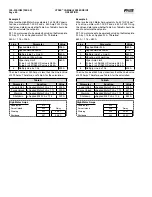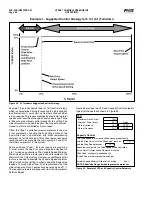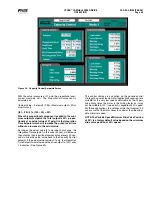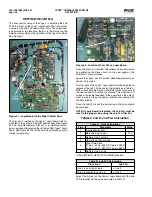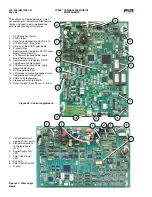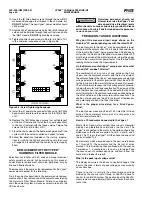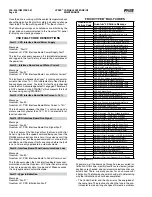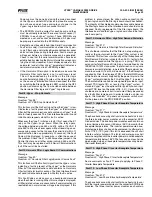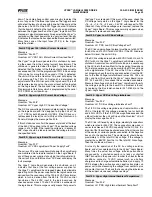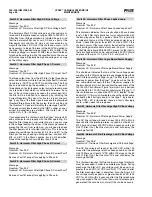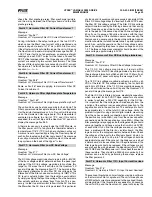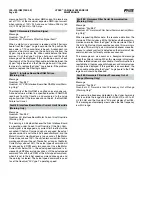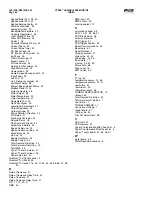
VYPER
™
VARIABLE SPEED DRIVE
MAINTENANCE
100-200 IOM (FEB 09)
Page 54
internal temperature sensors (5K ohm at 25°C) to monitor
their baseplate temperature. The inverter power module
baseplate temperatures shall be compared in software to a
lower limit of 37°F (2.8°C) and if this limit is exceeded the
unit shall initiate a cycling shutdown. In addition, if the three
Inverter baseplates and the Converter heat sink temperature
falls below the 37°F limit, the unit shall trip and the fan(s)
and water pump shall also be energized. This feature shall
provide the Service Dept. with a means to run the water
pump while filling the cooling system (by pulling VSD logic
board plug P2).
Fault 14: low Phase C Inverter Baseplate Temperature
Message
Quantum: “Fault 14”
Quantum LX: “Low Phase C Inverter Base plate Temperature”
Same comments as Fault 13 except applying to Phase C
Inverter Base plate Temperature
Fault 17: High Phase A Instantaneous Current
Message
Quantum: “Fault 17”
Quantum LX: “VSD High Phase A Instantaneous Current”
The three output lines to the motor are monitored via three
current transformers within the drive. The unit’s three phases
of instantaneous output current are compared to a prescribed
limit which is contained in hardware. If the peak current limit
is exceeded, the unit will trip and the Quantum
™
LX Panel will
display a fault message.
The Vyper
™
Logic board generates this shutdown. If any
one phase of motor current, as measured by the Output
Current Transformers, exceeds 771 Amps peak for 305 HP
/ 1200 Amps peak for 437 HP, a shutdown will occur. If an
Instantaneous Current occurs, but the chiller restarts and
runs without a problem, the cause may be attributed to a
voltage sag on the utility power feeding the Vyper
™
that is in
excess of the specified dip voltage for this product. This is
especially true if the chiller was running at or near full load.
If there should be a sudden dip in line voltage, the current
to the motor will increase, since the motor wants to draw
constant horsepower. This is a common problem when a
second chiller is started. Contact Frick factory service if this
is confirmed to be a problem.
Fault 18: High Phase B Instantaneous Current
Message
Quantum: “Fault 18”
Quantum LX: “: “VSD High Phase B Instantaneous Current”
Same comments as Fault 17 except applying to Phase B
Instantaneous Current
Fault 19: High Phase C Instantaneous Current
Message
Quantum: “Fault 19”
Quantum LX: “VSD High Phase C Instantaneous Current”
Same comments as Fault 17 except applying to Phase C
Instantaneous Current
Fault 21: Vyper Phase A Gate Driver
Message
Quantum: “Fault 21”
Quantum LX: “VSD Phase A Gate Driver Fault”
The unit’s phase bank assembly shall contain one IGBT
gate driver control board. This board monitors the satura-
tion voltage drop across each IGBT while gated on. If the
IGBT’s saturation voltage exceeds the prescribed limit, the
gate driver will make the determination that a short circuit
is present. This in turn shall cause the unit to trip and the
Quantum
™
LX Panel shall display the message Fault 21. If the
driver board’s power supply voltage falls below the permis-
sible limit, this same message shall be generated.
A second level of overcurrent protection exists on the Vyper
™
gate driver board. The collector-to-emitter voltage of each
IGBT is checked continuously while the device is being
turned on. This is also called the collector-to-emitter satura-
tion voltage. If the voltage across the IGBT is greater than a
set threshold, the IGBT is turned off and a shutdown pulse
is sent to the Vyper
™
logic board shutting down the entire
system. To diagnose the problem, first check the LED’s on
the gate driver board of the Vyper
™
power unit. Usually one
of the six LED’s will be out. This clearly points to a bad gate
driver, and requires replacement of the Vyper
™
power module.
If all LED’s are lit, and the problem repeatedly occurs in one
phase, swap all three pole cables at the logic board J8, J9,
and J10. Plug J8 into J9, J9 into J10, and J10 into J8. If the
display now reports a trip in a different phase, the problem
is either in the Vyper
™
power module or gate driver board, or
in the cable that feeds the gate driver board from the Vyper
™
Logic board. The fault could also be cause by a problem in
the drive line. Ensure that the compressor is free to rotate.
If the display continues to report a gate driver FLT in the
same phase, even with cables swapped, the problem is in the
Vyper
™
Logic board. Once you have finished troubleshooting,
be sure to put all of the cables back into their original mating
connectors. Also, be aware that a gate driver fault can be
initiated when the Vyper
™
is not running if a power supply
has failed on the gate driver board.
Check that the LRA rating of the motor is not higher than the
LRA rating of the drive.
Fault 22: Vyper Phase B Gate Driver
Message
Quantum: “Fault 22”
Quantum LX: “VSD Phase B Gate Driver Fault”
Same comments as Fault 21 except applying to Phase B
Gate Driver.
Fault 23: Vyper Phase C Gate Driver
Message
Quantum: “Fault 23”
Quantum LX: “VSD Phase C Gate Driver Fault”
Same comments as Fault 21 except applying to Phase C
Gate Driver.
Fault 24: Vyper Single Phase Input Power
Message
Quantum: “Fault 24”
Quantum LX: “VSD Single Phase Input Power Fault”
The Vyper’s SCR Trigger Control board contains circuitry that
checks the three-phase mains for the presence of all three
line voltages. If all line voltages are not present, the unit will
trip and the Quantum
™
LX Panel will display the message
Fault 24.
This shutdown is generated by the SCR Trigger board and
relayed to the Vyper
™
Logic board to initiate a system shut-

